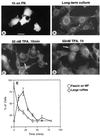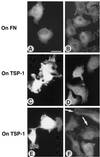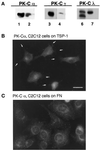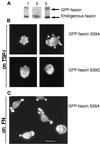Cell-matrix adhesions differentially regulate fascin phosphorylation
- PMID: 10588651
- PMCID: PMC25751
- DOI: 10.1091/mbc.10.12.4177
Cell-matrix adhesions differentially regulate fascin phosphorylation
Abstract
Cell adhesion to individual macromolecules of the extracellular matrix has dramatic effects on the subcellular localization of the actin-bundling protein fascin and on the ability of cells to form stable fascin microspikes. The actin-binding activity of fascin is down-regulated by phosphorylation, and we used two differentiated cell types, C2C12 skeletal myoblasts and LLC-PK1 kidney epithelial cells, to examine the hypothesis that cell adhesion to the matrix components fibronectin, laminin-1, and thrombospondin-1 differentially regulates fascin phosphorylation. In both cell types, treatment with the PKC activator 12-tetradecanoyl phorbol 13-acetate (TPA) or adhesion to fibronectin led to a diffuse distribution of fascin after 1 h. C2C12 cells contain the PKC family members alpha, gamma, and lambda, and PKCalpha localization was altered upon cell adhesion to fibronectin. Two-dimensional isoelectric focusing/SDS-polyacrylamide gels were used to determine that fascin became phosphorylated in cells adherent to fibronectin and was inhibited by the PKC inhibitors calphostin C and chelerythrine chloride. Phosphorylation of fascin was not detected in cells adherent to thrombospondin-1 or to laminin-1. LLC-PK1 cells expressing green fluorescent protein (GFP)-fascin also displayed similar regulation of fascin phosphorylation. LLC-PK1 cells expressing GFP-fascin S39A, a nonphosphorylatable mutant, did not undergo spreading and focal contact organization on fibronectin, whereas cells expressing a GFP-fascin S39D mutant with constitutive negative charge spread more extensively than wild-type cells. In contrast, C2C12 cells coexpressing S39A fascin with endogenous fascin remained competent to form microspikes on thrombospondin-1, and cells that expressed fascin S39D attached to thrombospondin-1 but did not form microspikes. Blockade of PKCalpha activity by TPA-induced down-regulation led to actin association of wild-type fascin in fibronectin-adherent C2C12 and LLC-PK1 cells but did not alter the distribution of S39A or S39D fascins. The association of fascin with actin in fibronectin-adherent cells was also evident in the presence of an inhibitory antibody to integrin alpha5 subunit. These novel results establish matrix-initiated PKC-dependent regulation of fascin phosphorylation at serine 39 as a mechanism whereby matrix adhesion is coupled to the organization of cytoskeletal structure.
Figures











References
-
- Adams JC. Formation of stable microspikes containing actin and the 55 kDa actin-bundling protein, fascin, is a consequence of cell adhesion to thrombospondin-1: implications for the antiadhesive activities of thrombospondin-1. J Cell Sci. 1995;108:1977–1990. - PubMed
-
- Adams JC, Watt FM. Regulation of development and differentiation by the extracellular matrix. Development. 1993;117:1183–1198. - PubMed
Publication types
MeSH terms
Substances
Grants and funding
LinkOut - more resources
Full Text Sources
Molecular Biology Databases

